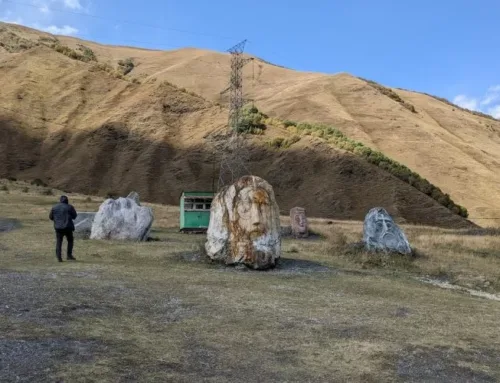Jvari monastery

The domed temple of Mtskheta Holly Jvari Monastery stands above Mtskheta, on top of the mount just across the Aragvi river. This temple immortalizes several consequential facts related to the enlightenment of the kingdom of Kartli. According to Georgian manuscripts, this is the very place where st. Nino had erected a big wooden cross that stood there for a rather long time until the high governor of Kartli – Erismtavari Guaram built “The Holly Cross minor church” in the second half of VI c.
The thee-particle structure, built in neatly hewn stone is finished with a cross-shaped arch that contains a central apse and contains room for a standing audience from the south and a porch from the north. The special niche with the image of the blossomed live cross, apparently designed as a place for privileged and honorable persons is arranged in the interior of the building. Soon after those undertakings of Guaram, his son and heir Stephanoz, I launched the construction of a monumental domed temple that would serve as a kind of repository of Holly relics – of the Holly Cross in this particular case. Construction activities were in progress through 586-604 AD. The octagonal pedestal of the Holly Cross still stands in the center of the temple interior.
The architect hired for those purposes has chosen the tetraconch as the basic configuration of the construction the pattern that had already been well-known in Georgia. For the purposes of gaining more space, cross-shaped rooms were arranged in between the apses, while the separated sections were connected by means of inches with the configuration of 3/4 of the circle that was arranged along the diagonal of the sub-dome square.
This combination is a new word in the history of architecture – a new Mtskheta Jvari type of architecture has been created. Thanks to the genius of the designer, the external shape of the construction perfectly correlates with and corresponds to its totally balanced internal space where the main pre-sanctuary axes are highlighted. The whole construction is presented as a unified and solid system of faceted interrelated elements. The construction, crowned with the dome neither presses the earth nor seems to have lost contact with it – full of grace and tranquility it stands on the edge of the Earth and Heavens.
Perfection of the ratio between the volumes are even more highlighted by means of sculptural ornamentation of the exterior – upper sections of window frames adorned with florist foils, rising images of church builders on the sanctuary and southern facades and risings with the scenes of “Elevation of the Holly Cross” and “Ascension of Jesus Christ” above the southern entrance. Highly specific risings with their own compositional and linear rhythm outline basic axes and tectonic elements of the building, and its architectural structure.
Full compatibility and incorporation of the temple with the surrounding landscape clearly demonstrate the sophisticated intuition and taste of the architect – one hardly can imagine that the mount had ever existed without the temple on the summit. The concordance between them is so strong that it’s even hard to claim for sure which origin is the determiner – the man-made structure or the natural rising.
The partially survived defensive wall is much younger as well as hermit sells are located southwestwards of the temple.
We always visit the Jvari monastery cathedral during our tour in Mtskheta.


















